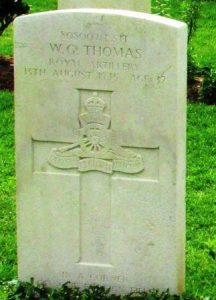Clydach is a village which originally lay in the historic county of Breconshire and is neighboured by the village of Gilwern and town of Abergavenny. It is split by the A465 Heads of the Valleys Road into North Clydach and South Clydach. The village was founded around an ironworks which has long since closed and is now within the boundaries of modern-day Monmouthshire. The men of Clydach who fell during both World Wars are commemorated on the recently erected Crickhowell and District War Memorial, which is located at Beaufort Street, near the site of the Crickhowell War Memorial Hospital. The memorial is split into sections commemorating the men, and women, of all of the local towns and villages and commemorates the fallen of the Great War, World War Two and the Iraq War.
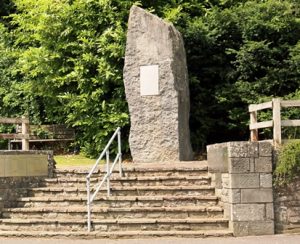
The Great War, 1914-1918
Ivor Beynon, Sapper, 5237, Canadian Engineers. Ivor was born at Tamworth, Staffordshire on 6 January 1886, the son of Evan Beynon and Maria Beynon (nee Neal). His father, a Welsh Minister from Llwydcoed, moved his family back to Wales by 1896, first to Ebbw Vale. By 1901 the family was residing at Ystradfodwg, then by 1911 at Merthyr Tydfil. During the summer of 1911 the family had moved to Hazeldene, Clydach, ad Reverend Beynon had become Minister of Ebenezer Chapel. Ivor had left Wales the previous year to begin a new life in Canada and had sailed for Quebec aboard the SS Royal George on 15 September 1910, before finding work on the Canadian railways. Ivor must have had a deep sense of patriotism, as he enlisted at Valcartier into the Canadian Expeditionary Force on 24 September 1914 and with his experience on the railways was posted to the 1st Field Company, Canadian Engineers. The company was attached to the newly raised 1st Canadian Division and once the division had completed its assembly, sailed for England on 3 October 1914, before disembarking eleven days later and entraining for Salisbury Plain. After completing its training there, the Division embarked for St Nazaire in early February 1915, before assembling in the Hazebrouck-Strazeele area by 15 February and moved into position in the Ypres Salient. The division, still inexperienced, was hurled into action at Ypres soon afterwards following a gas attack by the Germans upon a section of trenches held by French Colonial troops at Gravenstafel on 22 April. The Frenchmen fled in terror as the gas cloud drifted across the front line and men began drowning in their own lungs as the chlorine gas was inhaled. The Canadians had to advance into this terrible scene of death and devastation, marching past the retreating Frenchmen as they plugged the gap that had been left in the line, and ferocious fighting raged over the coming days. Ivor was guarding a bridge on the Yser Canal when he was killed by shrapnel from an exploding German artillery shell two days later, on 24 April 1915. The 30-year-old was buried on the battlefield, on the east bank of the Yser Canal, but after the war his grave was exhumed and he was re-interred in Duhallow A.D.S. Cemetery, Belgium. Soon after his death his father took up a position at a Chapel in Cwmpark. Ivor is not commemorated on the Clydach war memorial.
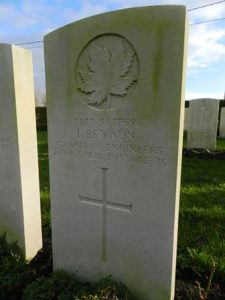
John Howells, Private, 8878, South Wales Borderers. John was born at Clydach, Breconshire in about 1887. He left home as a young man to enlist into the South Wales Borderers and by 1911 was stationed at Chatham with the 1st Battalion, South Wales Borderers. Following the outbreak of war, John embarked for France with the 1st Battalion, South Wales Borderers and disembarked at Le Havre on 13 August 1914. The battalion was attached to 3 Brigade, 1st Division and entrained for the Belgian frontier, near the town of Mons. The Division then took part in the Battle of Mons on 23 August, following the German invasion of the low countries, and in the epic withdrawal from Mons to the River Marne, where the German drive on Paris was halted. The Germans then withdrew north and took up defensive positions north of the river Aisne, along the Chemin des Dames Ridge and the BEF advanced before launching a frontal attack upon the German positions, in an action known as the Battle of the Aisne. The BEF then began moving to Flanders on 17 October, before advancing from Poperinghe past endless numbers of refugees and took up positions guarding the strategically vital city of Ypres, the 1st Division taking up positions near Langemarck by 21 October. Later that day the division was attacked by hordes of Germans, mainly young student-soldiers, who were mown down by the highly trained British soldiers. John was killed in action here at Langemarck on 21 October 1914. The 27-year-old has no known grave and is commemorated on the Ypres (Menin Gate) Memorial, Belgium. John is not commemorated on the Clydach war memorial.
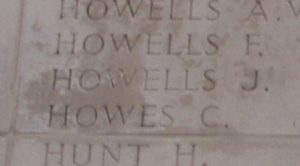
John Wesley Jones, Private, 37937, Somerset Light Infantry. John was born at Clydach, Breconshire on 25 September 1890, the son of John Jones and Catherine Jones. Just months after his birth the family had moved to 346, High Street, Cheltenham, where his father had gained a position as manager of a boot store, and they continued to live there for many years after. Upon leaving school, John began work as a clerk for the Great Western Railway at Stroud. He resigned his post on 9 May 1910 and began working as a clerk for a Drapers shop in Cheltenham. He enlisted at Cheltenham into the Royal Army Veterinary Corps soon after the outbreak of war. John was subsequently drafted to France during the early weeks of 1918 and was transferred to the 6th Battalion, Somerset Light Infantry, which was at Chipilly, in the Somme Valley, attached to 43 Brigade, 14th (Light) Division. The brigade was holding a sector of the line near Haute Tombelle at a position called Pie Wood and for the weeks following John joining, was carrying out the usual routines of trench rotation, usually spending for days in the front line, four in support, and four in reserve. On 18 March 1918 the 6th Somerset Light Infantry relieved the 7th KRRC in the front line here to begin a routine tour in the trenches. Unfortunately, at 04.30 on 21 March 1918 the Germans opened up a ferocious artillery barrage along a section of the Western Front running south from Croisilles to La Fère, which was followed up with gas shells and then an infantry assault, led by thousands of highly trained Stormtroopers. Despite putting up a brave stand, the 6th Somerset Light Infantry was overwhelmed. John was badly wounded early in the day and died of his wounds later that afternoon, on 21 March 1918. The 27-year-old is buried in Ribemont Communal Cemetery Extension, Aisne, France.
David William Lewis, Private, 39525, South Wales Borderers. David was born in 1896, the son of Elijah Lewis and Margaret Emily Lewis (nee Flight), of Station Road, Clydach, Breconshire. He enlisted at Abergavenny into the Monmouthshire Regiment, but after being drafted to France in the summer of 1916 was transferred to the 6th Battalion, South Wales Borderers, which was the Pioneer Battalion to the 25th Division. The division fought throughout the Battle of the Somme that summer, and then moved to Ploegsteert, where it held the line for the months leading up the Battle of Messines in June 1917. After fighting at Messines, the Division fought at the Pilckem Ridge, before moving south to the Arras Sector, taking up positions around Bullecourt in reserve. Here the Division was used to reinforce the badly depleted British units that were hit in the area by the German Spring Offensive of 21 March 1918. The Division then moved north to Flanders on the night of 30 March, where it took up positions at Ploegsteert again. On 9 April the Germans launched the second phase of their Spring Offensive along the Lys Valley, and the Division was caught up in the terrible fighting which ensued. The Division withdrew to Abeele to rest on 17 April, but on 25 April was ordered back into the line, and took part in the Second Battle of Kemmel. On 9 May the Division moved to Fismes, 20 miles south-east of Soissons in the Champagne, to give it a chance to rest and rebuild again. On 26 May the Division took up positions south of the Aisne, to guard against a predicted German Offensive. On the following morning, 27 May, the Germans hit the Division, and during the coming days the Division was virtually annihilated. David was killed in action here on 28 May 1918, during a day of ferocious fighting. The 21-year-old has no known grave and is commemorated on the Soissons Memorial, France.
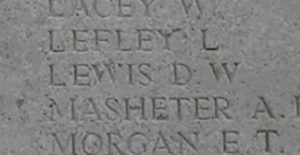
Henry Morgan, Private, 10515, King’s Shropshire Light Infantry. Henry was born in 1890, the son of Henry Morgan and Annie Eliza Eva Morgan (nee Bridges), of Ivy Cottage, Clydach, Breconshire. He enlisted at Hereford into the King’s Shropshire Light Infantry soon after the outbreak of war. Henry was drafted to France on 12 November 1914 and joined the 1st Battalion, King’s Shropshire Light Infantry, which was attached to 16 Brigade, 6th Division. The division had landed at St. Nazaire on 10 September 1914, in time to reinforce the hard-pressed BEF on the Aisne, before the whole army was moved north into Flanders from 14 October. The 6th Division moved to positions near Armentieres, at Bois Grenier where it remained over the coming months. At the end of May 1915, the division was relieved from here and transferred to positions in the Ypres Salient, taking over positions at Wieltje and Potijze. The division became caught up in the terrible fighting which followed the German flamethrower attack at Hooge during June 1915, but the line held, and the division remained in the same sector over the coming months. Henry was killed during a routine spell in the trenches at La Brique on 17 October 1915. The 25-year-old was buried in La Brique Military Cemetery No.2, Belgium.
Herbert Leonard Parry, Driver, W/4490, Royal Field Artillery. Herbert, known as Leonard, was born at Clydach, Breconshire in about 1896, the son of James Parry. He had enlisted into the Royal Field Artillery at Brecon soon after the outbreak of war and was posted to B Battery, 122nd Brigade, Royal Field Artillery, which was attached to the 38th (Welsh) Division. After training in North Wales and at Morn Hill, Winchester, the division began embarking for France from 2 December 1915, before moving to the Fleurbaix sector, where it was initiated into trench warfare. During June 1916 the Division marched south to the Somme, and on 7 July 1916 attacked Mametz Wood. The initial attack failed, and it was three days later, on 10 July, that a fresh attack was mounted. After two days of heavy hand to hand fighting within the wood, the Germans withdrew, and the battered Welshmen moved via Hébuterne to Boesinghe, on the Yser Canal, where it remained until launching its attack on Pilckem Ridge on 31 July 1917. The 15th Welsh remained in the line, and also took part in the Battle of Langemarck, before the entire Division was moved to positions near Armentieres over the winter. After the Germans launched their offensive on the Somme on 21 March 1918, the Division was moved back to the Somme, and took up positions north of Albert, around Aveluy Wood. On 21 August 1918 the division launched an assault across the Ancre Valley and captured Thiepval Ridge and Pozieres, before taking part in the great advance towards the Hindenburg Line which ultimately won the war. Leonard took ill just weeks prior to the Armistice and was evacuated to hospital at Rouen, where he died of influenza on 13 November 1918. The 22-year-old is buried in St. Sever Cemetery Extension, Rouen, France. Leonard had been home on leave late in 1917 and married Mary Ann Wakeford, of 116, William Street, Ystrad, Rhondda. He is not commemorated on the Clydach war memorial.
William Hayden Phillips, Private, 81015, The King’s (Liverpool Regiment). William was born in 1897, the son of William Phillips and Clara Phoebe Phillips (nee Williams), of Heathbush, Clydach, Breconshire. He enlisted at Newport into the South Wales Borderers during the early months of 1916, and after completing his training was posted to the 2nd (Garrison) Battalion, The King’s (Liverpool Regiment). The battalion had been formed at Pembroke Dock in November 1915, before embarking for Egypt in March 1916 and moved to Salonika in January 1917 on Lines of Communication work. William had only been in Salonika for little over a month when he was killed on 27 February 1917. The 20-year-old is buried in Salonika (Lembet Road) Military Cemetery, Greece.
Thomas Arthur Powell, Lance Corporal, G/24807, The Queen’s Own (Royal West Kent Regiment). Thomas was born Clydach, Breconshire in 1896, the son of Sarah Powell. He lived at Adpar, Newcastle Emlyn prior to enlisting into the Welsh Horse Yeomanry. He was among a number of men transferred from the Welsh Horse to the 7th Battalion, Queen’s Own (Royal West Kent Regiment) prior to its embarking for France on 27 July 1915 as part of 55 Brigade, 18th (Eastern) Division. The division didn’t see its first major action until July 1916 when it took part in the Battle of Albert, but then fought through the remainder of the Somme offensive. It followed the German withdrawal to the Hindenburg Line in March 1917 and in May took part in the Third Battle of the Scarpe, which was part of the Arras Offensive. July 1917 saw the Division at Ypres, where they took part in the Battle of Pilckem, where they helped capture Westhoek. Thomas was killed in action here on 3 August 1917, aged 21. He has no known grave and is commemorated on the Ypres (Menin Gate) Memorial, Belgium.
William Henry Price, Gunner, 13128, Royal Field Artillery. William was born at Clydach, Breconshire in 1885, the son of Benjamin Price and Emma Price (nee Lewis). By 1891 the family had moved to 118, Abertillery Road, Blaina, where his father had found work as a coalminer. William also worked as a coalminer after leaving school, but soon after the outbreak of war left his job to enlist at Newport into the Royal Field Artillery. He was then posted to France, joining the 30th Battery, 39th Brigade, Royal Field Artillery. The battery had been in France since August 1914 and was attached to the 1st Division. William probably joined it in the summer of 1916, during the time of the Battle of the Somme. The division wintered on the Somme, then early in 1917 moved to the Flanders coast, to prepare for a possible offensive along the coast, code-named ‘Operation Hush’. The divisional artillery set up near Coxyde and over the coming months carried out artillery shoots against strategic German targets, as well as carrying out artillery support for the divisions infantry units as they carried out trench raids. William was killed in action here on 3 July 1917, during a relatively quiet day. The 32-year-old is buried in Coxyde Military Cemetery, Belgium. As it transpired, Operation Hush was called off and the 1st Division was later moved to Ypres to take part in the latter stages of the Passchendaele offensive.
World War Two, 1939-1945
Mervyn Tasse Andrews, Driver, 1922152, Royal Engineers. Mervyn was born in 1919, the son of Frederick William Andrews and Jane Andrews (nee Field), of Library Cottage, Clydach. He enlisted into the Royal Engineers soon after the outbreak of war and was posted to 59 Bomb Disposal Section, Royal Engineers. The unit was one which had been formed after the outbreak of war specifically to deal with unexploded German bombs, an obviously tremendously hazardous role which required men with nerves of steel. Mervyn was killed whilst attempting to defuse an unexploded bomb behind 117, Welwyndale Road, Sutton Coldfield, Birmingham on 25 August 1940, when the bomb exploded, killing seven sappers and wounding another who subsequently died. The bomb had been dropped during a terrible two-day period of bombing which saw the Bull Ring destroyed. The remains of the 20-year-old were brought home and he was buried in St. Ellyw Churchyard, Llanelly.
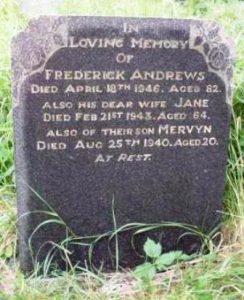
Francis Charles Edmunds, Lance Corporal, 4078125, Pioneer Corps. Francis was born in 1921, the son of William Edmunds and Mary Edmunds (nee Jones), of Ynys-y-Garth, Clydach. He enlisted into the army soon after the outbreak of war and was posted to the Pioneer Corps. Francis died at home on 31 July 1944, aged 23. He was buried three days later in St. Ellyw Churchyard, No. 2 Extension, Llanelly. Francis is not commemorated on the Clydach war memorial.
Brinley Evans, Lance Corporal, 4197949, King’s Shropshire Light Infantry. Brinley was born at Clydach, Breconshire on 8 March 1918, the son of Alfred Thomas Evans and Mary Evans (nee Price). The family had moved to Troed-y-Wennol, Govilon, Monmouthshire prior to the war, where Brinley and his father both worked as coalminers. Brinley enlisted into the army and was posted to the 2nd Battalion, King’s Shropshire Light Infantry. The 2nd Battalion began the war stationed in Jamaica and Bermuda, before returning to Europe to join the 185th Infantry Brigade, which included the 2nd Battalion, Royal Warwickshire Regiment and the 1st Battalion, Royal Norfolk Regiment, of the 79th Armoured Division. The 185th Brigade then transferred to the 3rd Infantry Division in April 1943 and began to prepare for the invasion of Sicily. Plans then changed and the division returned to England to prepare for the Normandy Landings, which took place on D-Day, 6 June 1944. The division then took part in the efforts to capture the town of Caen but failed due to a heavy resistance put up by the elite German 21st Panzer Division. Brinley was killed in Normandy on 1 July 1944. The 28-year-old was originally buried on the battlefield, near the village of Cheux, but in September 1945 his grave was exhumed, and he was re-interred in St. Manvieu War Cemetery, Cheux, France.
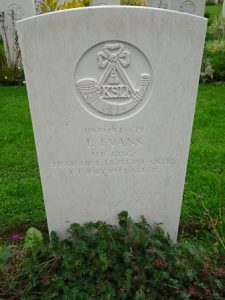
Arthur Reginald Thomas, Gunner, 14320807, Royal Artillery. Arthur was born at Clydach in about 1923. He enlisted into the Royal Artillery and was posted to the elite 3rd Airlanding Anti-Tank Battery, Royal Artillery. The battery had formed at Marlborough Barracks, Bulford, Wiltshire on 9 May 1943, the bulk of its men coming from ‘C’ Battery, 103rd Anti-Tank Regiment, Royal Artillery and was formed to provide defence to the parachute brigades of the 6th Airborne Division. Members of the battery landed in Normandy with the 6th Airborne Division on D-Day, tasked with the capture of the Caen canal and Orne River bridges, as well as in Operation Tonga, the Battle of Merville Gun Battery, and Operation Mallard. Some guns of the battery came over aboard Landing Craft during the morning to join the fray. The 6th Airborne Division moved back to Britain after the capture of Bréville-les-Monts, during a bloody battle which ended on 13 June and returned to Britain to rebuild. On 23 December 1944 the division moved to Belgium, to help counter the German breakthrough, known as the Battle of the Bulge and once the Germans had been stopped, advanced into Holland. Where the division held the area along the River Maas between Venlo and Roermond. Near the end of February 1945, the 6th Airborne Division returned to England to prepare for another airborne mission; to cross the river Rhine, during an operation code-named Operation Varsity and Operation Plunder. The airborne operation was preceded by two days of bombing by the RAF and USAAF, then on 23 March some 3,500 artillery guns targeted the German positions. That evening an amphibious assault was carried out across the Rhine by the 21st Army Group. The 6th Airborne Division was assigned to the U.S. XVIII Airborne Corps, serving alongside the American 17th Airborne Division, taking part in the largest Allied airborne operation of the war as the combined force landed in drop zones on the east side of the Rhine near Hamminkeln and Wesel in Germany. Arthur took off from England with the 3rd Airlanding Anti-Tank Battery on 24 March 1945 and landed near Hamminkeln. He was killed in action that same day, 24 March 1945, during ferocious fighting. The 21-year-old was originally buried in Hamminkeln Cemetery, Germany, but in May 1947 the war graves in the cemetery were exhumed and Arthur was re-interred into Reichswald Forest War Cemetery, Germany.
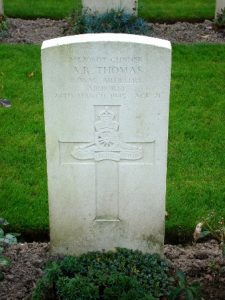
William George Griffith Thomas, Lance Serjeant, 808007, Royal Artillery. William was born at Clydach on 18 November 1912, the son of Benjamin George Thomas and Ellen Thomas (nee Charles). He married Irene Emily Born at Woolwich in 1937 and the couple set up home at Plumstead, London. William enlisted into the Royal Artillery soon after the outbreak of war and was posted to Singapore in December 1940 to join the 9th Coast Regiment, Royal Artillery. His wife then went to live with his parents, who had by now moved to the Railway Inn, at Clydach. The regiment formed part of the formidable defensive system for the strategically important city of Singapore. The Japanese invaded Malaya and Thailand from Indochina on 8 December 1941 via an amphibious assault, in conjunction with their raid on the American base of Pearl Harbour, and swiftly forced Thailand to capitulate. This allowed the Japanese to concentrate their efforts on advancing into Malaya and Two days later, Force Z, consisting of the battleship HMS Prince of Wales, the battlecruiser HMS Repulse and several destroyers, was sunk by Japanese aircraft and the fortress of Singapore was soon under attack. January 1942 was a month of ferocious fighting for Singapore and many atrocities were carried out by the invading Japanese as, bit by bit, the garrison succumbed. Despite overwhelming superiority in troop numbers, Singapore was surrendered to the Japanese by Lieutenant-General Arthur Percival on 15 February 1941 and some 85,000 Allied troops were marched into captivity. The Coastal Batteries had been destroyed three days earlier and the garrison had fought as infantry right up until the surrender, its survivors being marched into captivity at Changi. William was among a large number of prisoners shipped to French Indochina to be used as forced labour and was taken to a POW camp near Saigon. He survived for over three years in terrible conditions before dying in captivity on 13 August 1945, reportedly of appendicitis. The 32-year-old was originally buried in Saigon Military Cemetery, but in March 1954 the burials within the cemetery were exhumed and William was re-interred in Kranji War Cemetery, Singapore.
